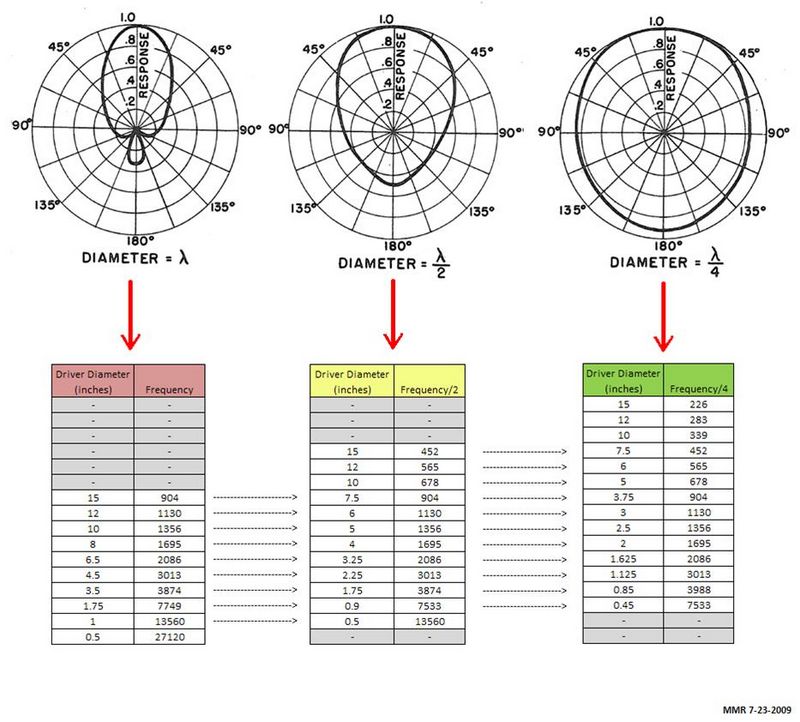 Аудио-википедия
Аудио-википедия
База знаний по hi-fi и high-end технике и комплектующим, отзывы и впечатления
Инструменты пользователя
Боковая панель
Это старая версия документа!
Beaming. Размеры динамиков и диаграмма направленности
Well… sort of. I'm going to offer some personal opinions that you might disagree with, but here it goes.
I like that you're doing the math and figuring out how high you should go with the midrange driver. (In this case, a 2.5« diameter driver) A 2.5» wavelength would equal about 5400Hz, however there's more to the story. I did some research a few years back and found that calculating for one wavelength doesn't give you the dispersion/ beaming that you think it does.
Take a peek at the chart I created. It was derived from research done waaaaay back.
It looks like a confusing mess at first. Start with the diagram on the left. This is what your calculations are producing. When the diameter of the driver approaches the wavelength that you're trying to produce, then you get the first diagram on the left. This dispersion pattern is not very good. Off axis response is far worse than you might have expected when you were doing your «beaming» calculations.
If you were to limit the 2.5« driver to the frequency associated with half of a wavelength instead of one wavelength, your dispersion would look more like the second figure. Ahhhhh, now that's better! (See the middle diagram.) This is what people are trying to show when they talk about beaming.
Taking this to the next logical step, look at how amazing the dispersion is if you limit the driver to one quarter of a wavelength. See the diagram on the right.
Reality kicks in… It's not quite practical to limit your 2.5» diameter midrange driver to an upper limit of 1356 Hz (see chart, green section), so some compromises need to be made. Having the midrange's upper limit be 1356 Hz would dictate having the tweeter ROLL ON at 1356 Hz, and that is rarely done for several reasons, most obvious is that you will burn the tweeter out fairly quickly.
So in general I try to use the green section (1/4 wavelength) of the chart whenever possible to get the best dispersion. That's fairly easy for low frequencies (woofers) but I usually end up with the yellow section (1/2 wavelength) for midrange drivers.
Let's get specific with your chosen drivers: In your case, a 2.5« midrange can produce the dispersion shown in the middle diagram if you limit it's upper freq to about 2700Hz. (By pushing the 2.5» mid up to 5400 Hz it would produce the dispersion shown in the left diagram…not good) Now, the good news is that most tweeter's can easily handle the power when rolled on at 2700Hz. So crossing the mid to tweeter any higher than 2700 Hz just makes your dispersion/ beaming worse.
Does this make any sense? You were on the right track with your math, but I would respectfully suggest modifying your calculations by a factor of 2 (or 4) to give better results. This can sometimes mean using a smaller diameter driver to get better dispersion. In your case, your 2.5« mid is among the smaller midrange drivers already… so that's a bonus.
Try re-running the calculations with a six-inch midrange. They're not so pretty… with an upper limit of 1130 Hz in order to obtain the yellow dispersion shown in the middle of the chart. How the heck are you going to roll-on a tweeter at 1130 Hz? So picking a smaller diameter like 2.5» allows you to push it's upper limit to 2700Hz. Perfect!
This just goes to show that everything in speaker design is tradeoffs. I prefer using small diameter drivers for the midrange frequencies and picking low crossover frequencies to obtain the best dispersion I can (as compared to 5 or 6« midrange drivers) As long as the drivers can handle the power and excursion limits associated with low crossover points, it should improve the dispersion and reduce beaming problems.
A quick 3-way example: An 8» woofer can easily play up to 200 Hz and still be in the green section of the chart. (great dispersion!)
Add to that → a 2.5« mid playing 200 Hz to 1700 Hz (almost in the green section… great dispersion!)
Add to that → a tweeter capable of playing 1700 Hz to 20 kHz and you've got a very wide dispersion design that minimizes beaming effects.
It's physics! Use this knowledge to your advantage to pick crossover frequencies that make sense and produce better results.

